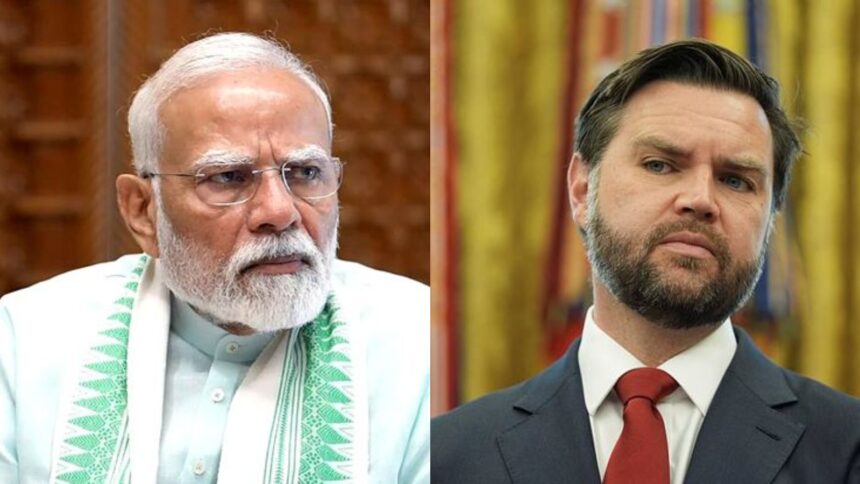The Indian precision strikes on Pakistani air bases early Saturday came hours after US Vice President J D Vance called up Prime Minister Narendra Modi on the night of May 9 and shared information about “alarming intelligence” that there was a “high probability for dramatic escalation if the conflict went into the weekend”.
It is learnt that the Prime Minister told Vance that India’s response would be “harder, deeper and bigger” to any Pakistani misadventure. And the Indian armed forces struck after Pakistan attempted to hit 26 locations on India’s northern and western frontiers.
These details, which emerged Sunday, a day after the announcement of a ceasefire, were in sync with the government’s instruction to the military after it struck nine terror sites in Pakistan and Pakistan-occupied Kashmir on May 7. The Prime Minister is learnt to have said, “Wahan se goli chalegi, toh yahan se gola chalega (if bullets come from the other side, it will be responded with shells)”.
On May 9 night and until the early hours of May 10, Pakistan attacked at 26 places, but these attempts were thwarted by Indian air defence systems. It was a significant scaling up by Pakistan of its aerial attacks with drones, which averaged about 10 locations earlier.
In retaliation, the Indian armed forces attacked Pakistani military bases at eight locations: air-launched precision weapons from fighter aircraft targeted Rafiqui, Murid, Chaklala, Rahim Yar Khan, Sukkur and Chunian and precision munitions also hit radar sites at Pasrur and the Sialkot aviation base.
“It was a hellfire,” sources said, underlining that the runway of the PAF base in Rahim Yar Khan was damaged and there was serious damage to the Nur Khan air base in Chaklala, Rawalpindi.
This, sources said, was the critical turning point on May 10, after which Pakistan approached the US.
There were calls between Pakistan Army chief General Asim Munir and US Secretary of State and National Security Advisor Marco Rubio, where they showed their willingness to talk to India.
Rubio spoke to External Affairs Minister S Jaishankar who said India was willing to talk, and that was conveyed earlier as well.
As a result, Pakistan’s Director General of Military Operations Major General Kashif Abdullah reached out to the Indian DGMO Lt General Rajiv Ghai around 1 pm May 10, and a call was set up at 3.30 pm. And they decided to stop firing and military action.
From the Indian perspective, the main objectives since the April 22 Pahalgam terror attack have been achieved: political, military and psychological.
The overarching thinking within the government was that there had to be a “higher cost” to Pakistan’s actions that had led them to undertake a cross-border terrorist act killing 26 people, all tourists barring one.
So, in the political vector, this led to a series of diplomatic measures including the most significant one of keeping the Indus Waters Treaty in abeyance. Sources said that with the three wars and the last four decades of cross-border terrorism, Pakistan had violated the fundamental principle of the pact that was concluded “in a spirit of goodwill”. It was felt that Pakistan cannot continue to not feel the heat because “blood and water cannot flow together” post-Pahalgam.
In the military vector, India had a playbook from the 2016 Uri surgical strike and 2019 air strike. Sources said the same thinking of “imposing costs” was there, but the government didn’t want to play the same cards – to retain the surprise element.
So, targets and techniques were chosen carefully, which included the nine terror locations in Pakistan and PoK. The three terror sites of Muridke, Bahawalpur and Muzaffarabad were not just high-value terrorist targets, but were also “symbolic” since they represented the headquarters of Lashkar-e-Taiba and Jaish-e-Mohammed.
“The message was clear: we will hit you, and we will hit you in your headquarters, not in some camps,” the sources said, underlining the new red line drawn by .
And, the psychological vector, the source said, was a combination of political and military. “There were two elements to this strategy: raise costs on Pakistan, and that no place is safe for you (terrorists),” sources said.
India, sources said, had been clear about its intention to hit terrorists ever since the Pahalgam terror attack. From Prime Minister Modi to External Affairs Minister Jaishankar to NSA Ajit Doval, they had all indicated this to their counterparts in phone conversations between April 22 and May 7.
And, after the Indian armed forces struck at nine terror sites on May 7 between 1 am and 1.30 am, Lt Gen Ghai called up his Pakistani counterpart and told him that India had hit the “carefully chosen” terror targets and that they had not targeted military targets. And finally, a message was sent that if Pakistan wants to talk, India is willing to engage.
The brief and the message to the entire world, who called Indian leaders, was straightforward: “If they fire at us, we fire at them. If they stop, we will stop.” This was reiterated to all foreign leaders and ministers who spoke to Modi, Jaishankar and Doval.
Over the next three days, Pakistan attacked India through drones and missiles on May 8, 9 and then 10, and these attempts were mostly thwarted. While the attacks between May 7 and 9 were at 8-10 locations each, the Pakistanis scaled it up and mounted the most “ambitious attack” on May 10 when they targeted even places as far as Sirsa.
India’s “hellfire” response followed on eight of Pakistan’s military bases, one of them even close to their nuclear installations.
The source said the gap between the Indian and Pakistani military and technological prowess was evident from the response of the Indian armed forces which demonstrated Delhi’s higher and stronger capability. “They got bashed on May 10,” sources said.
That is when Pakistan approached the Americans, seeking their help to stop the military action. So, when Rubio spoke to him, Jaishankar is learnt to have said that the offer was extended to the Pakistani side by the Indian DGMO on the first day itself – referring to the call between the DGMOs in the early hours of May 7 – just after 1.30 am.
The only communication channel that exists now is between the DGMOs, and there are no other channels of communication between India and Pakistan.
The sources also underlined that the three vectors of political, military and psychological warfare was aimed at establishing a “new normal” – no business as usual, and there will be costs to Pakistan’s cross-border terrorist actions.
The US involvement on the last day, Delhi said, was at the instance of Pakistan, and Trump possibly had the knowledge through Pakistan’s interlocutors, said sources who played down Washington’s role in brokering a truce between the two militaries.
Delhi is clearly not comfortable with Washington’s claim for credit, as Trump was the first to announce the truce. And, his latest offer to mediate has also not gone down well. “The only issue is getting Pakistan to vacate Pakistan-occupied Kashmir,” sources said.
Operation Sindoor, sources said, is not yet over, implying operational readiness to respond to challenges from Pakistan. They also don’t want to describe this as a ceasefire, calling it stopping of military action and firing.
Sources said the ceasefire agreement of February 2021 has been violated by Pakistan in the last few months, and they can’t go back yet.








